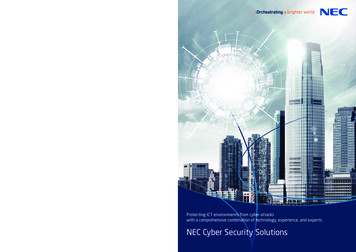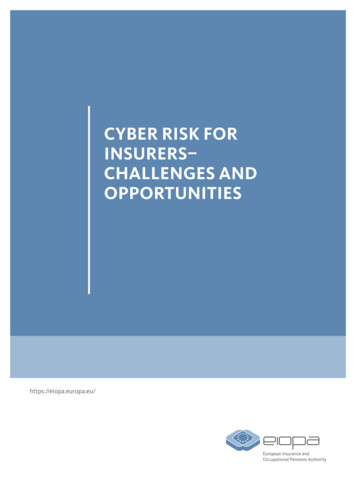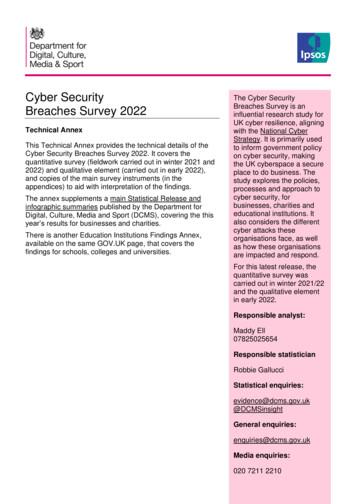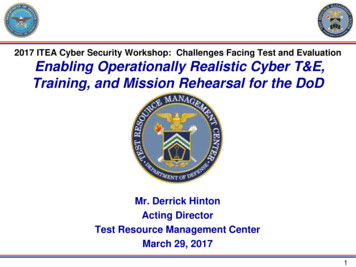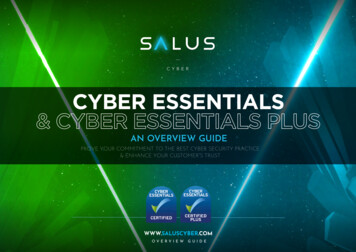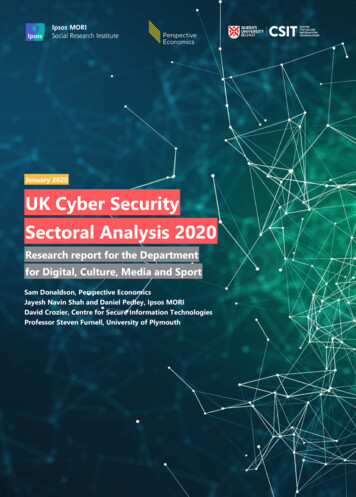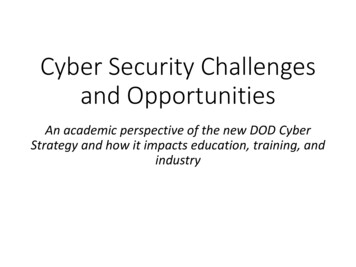
Transcription
Cyber Security Challengesand OpportunitiesAn academic perspective of the new DOD CyberStrategy and how it impacts education, training, andindustry
US Cyber Security Challenge U.S. prosperity and security depend on open andreliable access to information. Nations that are deterred from directly confrontingU.S. military strength are using cyberspaceoperations in day-today competition to exploit aperceived advantage and harm our interests. China and Russia are engaging in great powercompetition via persistent, aggressive cyberspacecampaigns that pose strategic, long-term risks tothe Nation, our allies, and partners.The United States cannot afford inaction: our values, economic competitiveness,and military edge are exposed to threats that grow more dangerous every day
Strategic Competition in CyberspaceGoals We must ensure the U.S. military’s ability to fight and win warsin any domain, including cyberspace. This is a foundational requirement for U.S. national security and a key to ensuringthat we deter aggression, including cyber attacks that constitute a use of force,against the United States, our allies, and our partners. Preempt, defeat, or deter malicious cyber activity targeting U.S.critical infrastructure that could cause a significant cyber incident Our primary role in this homeland defense mission is to defend forward byleveraging our focus outward to stop threats before they reach their targets. TheDepartment also provides public and private sector partners with indications andwarning (I&W) of malicious cyber activity, in coordination with other Federaldepartments and agencies. Strengthen cyber capacity, expand combined cyberspaceoperations, and increase bi-directional information sharing inorder to advance our mutual interests.
What is the Cyber Threat Landscape Cyber threats confronting the US are multifaceted and evolving,ranging from individual hackers to hacktivists to criminals toterrorist organizations to nation-states or those that theysponsor, directly or indirectly. Complex threat spectrum affects both public and private sectors,the interface and intersections between them, as well asindividual citizens. National security, economic security, andintellectual property are just some of the major interests atstake. A differentiation needs to be made among nuisance hacks, actsof espionage & true cyber attacks to proportionately defendagainst the most egregious threats. Attribution Retribution/retaliation
Key Themes Using cyberspace to amplify military lethalityand effectiveness; Defending forward, confronting threats beforethey reach U.S. networks; Proactively engaging in the day-to-day greatpower competition in cyberspace; Protecting military advantage and nationalprosperity; Recognizing partnerships are key to sharedsuccess in protecting cyberspace;
Key Themes Actively contesting the exfiltration of sensitiveDoD information; Embracing technology, automation, andinnovation to act at scale and speed; Supporting the defense of criticalinfrastructure; Recruiting, developing, and managing criticalcyber talent.
DoD Objectives for Cyberspace1. Ensuring the Joint Force can achieve its missions ina contested cyberspace domain;2. Enhancing Joint Force military advantages throughthe integration of cyber capabilities into planningand operations;3. Deterring, preempting, or defeating maliciouscyber activity targeting U.S. critical infrastructurethat is likely to cause a significant cyber incident;4. Securing DoD information and systems, includingon non-DoD-owned networks, against cyberespionage and malicious cyber activity;5. Expanding DoD cyber cooperation with allies,partners, and private sector entities
Cultivate Talent (1 of 2) Embed software and hardware expertise as acore competency: To make it attractive to skilled candidates, establish a career trackfor computer science related specialties (including hardwareengineers, software developers, and data analysts) that offersmeaningful challenges, rotational billets at other Federaldepartments and agencies, specialized training opportunities tied toretention commitments, and the expansion of compensationincentives for the Cyber Excepted Service (CES). Establish a cyber top talent managementprogram: Provides most skilled cyber personnel with focused resources andopportunities to develop key skills over the course of their careers. Use competitive processes, including individual and teamcompetitions, to identify the most capable DoD military and civiliancyber specialists and then empower those personnel to solve theDepartment’s toughest challenges.
Cultivate Talent (2 of 2) Sustain a ready cyber workforce: Invest in building future talent, identifying and recruiting sought-aftertalent, and retaining current cyber workforce. Provide ample opportunities for professional development and careerprogression of cyber personnel. Ensure that cyber requirements are filled by the optimal mix of militaryservice members, civilian employees, and contracted support to servemission requirements. Enhance the Nation’s cyber talent: DoD plays an essential role in enhancing the Nation’s pool of cyber talentin order to further the goal of increasing national resilience across theprivate and public sectors. It increase efforts to promote science, technology, engineering,mathematics, and foreign language (STEM-L) disciplines at the primaryand secondary education levels throughout the United States. DoD will also partner with industry and academia to establish standardsin training, education, and awareness that will facilitate the growth ofcyber talent in the United States.
Interpreting the new DODStrategy Persistence Persistent Engagement Persistent Presence in adversaries’cyberspace Persistent Innovation – faster thanadversaries Must maintain constant contact with ouradversaries Superiority in this domain is dynamic ( andtenuous) Must adjust to the new environment
Efforts to Define CyberEducation & Training
Fundamental “truths” ofcyberspace operations:1.2.3.4.Humans are more important than hardware.Quality is more important than quantity.Cyber forces cannot be mass produced.Competent cyber forces cannot be createdafter an emergency occurs.5. Most cyberspace operations will requiresupport from non-cyber forces.
Bounding Cyber Security
Cyber-relatedAcademic Credentials Two existing and new areas to link cyber studies: ABET: Nonprofit, non-governmental accrediting agency forprograms in applied and natural science, computing,engineering and engineering technology New Cybersecurity criteria NSA and DHS sponsored National Centers ofAcademic Excellence in Cyber Defense (CD) andCyber Operations (CO)
ABET New Cybersecurity Criteria Applies to computing programs using cybersecurity,computer security, cyber operations, informationassurance, information security, or similar terms intheir titles. At least 45 semester credit hours (or equivalent) ofcomputing and cybersecurity course work. The course work must cover: Application of the crosscutting concepts of confidentiality,integrity, availability, risk, and adversarial thinking. Advanced cybersecurity topics that build on crosscuttingconcepts and fundamental topics to provide depth. At least 6 semester credit hours (or equivalent) ofmathematics that must include discrete mathematicsand statistics.
ABET New CybersecurityFundamental topics Data Security: protection of data at rest and in transit. Software Security: development & use of software that reliablypreserves security properties of information and systems System Security: establishing & maintaining security propertiesof systems, including those of interconnected components. Human Security: protecting individuals’ personal data andprivacy; threat mitigation combined with the study of humanbehavior as it relates to cybersecurity. Organizational Security: protecting organizations fromcybersecurity threats & managing risk to support successfulaccomplishment of the organizations’ missions. Societal Security: aspects of cybersecurity that can broadlyimpact society as a whole for better or for worse.
National Centers of Academic Excellence inCybersecurity Cyber Defense (CAE-CD): NSA & DHS jointly sponsored Goal: reduce vulnerability in national informationinfrastructure by promoting higher ed and researchin cyber defense and producing professionals withcyber defense expertise Cyber Operations (CAE-CO) Emphasis on technologies & techniques related tospecialized cyber operations, to enhance the Nationalsecurity posture; critical to intelligence, military and lawenforcement organizations authorized to perform thesespecialized operations.
US Naval Academy Cyber EducationTurning Midshipmen into Cyber Warriors
Importance ofCyber Education at USNA The Cyber Domain is a warfighting domain just likeSea, Land, Air, and Space Adversaries and threats are not going away, they areadapting, becoming asymmetric, more challenging All of our graduates will serve as officers in units andfields which will all rely on depend on CyberOperations and Cyber Security Mission Assurance and Success depend on it We must ensure our future officers and leadersunderstand this complex domain as they do all others While our incoming student body is highly technical, theirunderstanding of this domain is limited in scope
USNA Strategic Challenges Educate all of our students on the importanceof Cyber Security and the Cyber Domain as awarfighting area Develop cyber-related course(s) of study Create a viable path for accessions of juniorofficers into the Information WarfareCommunity
USNA Cyber Education EffortsPrograms and FacilitiesCyber InternshipsCyber CompetitionsInternational ExposureCyber related ClubsCyber Lecture seriesProfessional CoreCompetenciesCurricular ElementsCyber Operations majorCyber Semesters AbroadFewManyAllInnovative/Creative Design projectsSingle/multi-disciplinary electivesTwo required Cyber corecourses for All MidshipmenGoal: Prepare Graduates to Lead in an Evolving Cyber Domain
Other Thoughts Educate, educate, educate train, train, train The human in the loop continues to be the weak link inthe majority of all attacks Cyber Security is not a “fad”, all levels of theworkforce, from the top down/bottom up, needincreased awareness and better understanding Enable better information sharing with privatesector, industry, government – that can’t bemandated, must be “owned” by all parties When cyber attacks can be attributed attributethem publicly, let others know of the threat
Director, NSA: What Keeps Him Up AtNight 1. Cyber attacks that do infrastructure damage: "It is only a matter of 'when' thatsomeone users cyber as a tool to do damage to the critical infrastructure of our nation,I'm watching nation states, groups within some of that infrastructure. At the moment,it seems to be really focused on reconnaissance and attempting to understand thecharacteristics of the structure, but it's only a matter of time I believe until someoneactually does something destructive." 2. Data manipulation: "Historically, we've largely been focused on stopping theextraction of data and insights, whether for intellectual property for commercial orcriminal advantage, but what happens when suddenly our data is manipulated and youno longer can believe what you're physically seeing? As a military guy, who's used tothe idea that, 'I can look at a display, I can look at a set of data, and I can very quicklydraw conclusions and start to make risk-based decisions quickly,' what happens if thatgets called into question? I believe that's going to happen." 3. Non-state actors: "What happens when a non-state actor, who literally has nointerest in the status quo — take ISIL for an example, whose vision of the world isdiametrically opposed to ours — starts viewing the web as not just a vehicle togenerate revenue, to recruit, to spread the ideology, but instead they view it as aweapon system?"
Questions
Back up slides
Safeguarding your Home NetworkSecure Your Wireless Router: Unless you secure your router, you’re vulnerable to people accessinginformation on your computer, using your Internet service for free and potentially using your networkto commit cybercrimes.Here are ways to secure your wireless router: Ensure your WiFi encryption is on: When choosing your router’s level of security, opt for WPA2, ifavailable, or WPA WEP is weak and breakable ( 30-seconds to break with free software). Change the default name of your router: The default ID - called a service set identifier” (SSID) or“extended service set identifier” (ESSID ) – is assigned by the manufacturer. Change your router to aname that is unique/obscure ( not “GoNavy”) and won’t be easily guessed by others. You can alsodisable your SSID broadcast so Change the default password on your router: When creating a new password, make sure it is longand strong, using a mix of numbers, letters and symbols. Use a firewall: Firewalls help keep hackers from using your computer to send out your personalinformation without your permission. While anti-virus software scans incoming email and files, afirewall is like a guard, watching for attempts to access your system and blocking communications withsources you don't permit. Your operating system and/or security software likely comes with a preinstalled firewall, but make sure you turn on these features. Create a guest password: Some routers allow for guests to use the network via a separatepassword. If you have many visitors to your home, it’s a good idea to set up a guest network.
Safeguarding your Online Activity Keep a clean machine: Having the latest security software, web browser, and operatingsystem are the best defenses against viruses, malware, and other online threats. Protect all devices that connect to the Internet: Along with computers, smart phones,gaming systems, & other web-enabled devices need protection Plug & scan: “USBs” and other external devices can be infected by viruses & malware. Ifyou must use them ( DOD doesn’t allow USB drives ), scan them first. Protect your : When banking & shopping, check to be sure the sites is securityenabled. Look for web addresses with “https://” which means the site takes extrameasures to help secure your information. [“http://” is not secure it has no s)] Back it up locally ( not in a cloud): Protect your valuable work, music, photos, andother digital information by making an electronic copy and storing it safely. Free WiFi is not free: Free and/or Public networks should never be assumed to besecure
Impose Consequences – the away fight- All instruments of power – far more than cyberRequiresAttribution[re]Active Defense – the local, close in, fight- Active engagement of adversaries- Hackback- Public and Private sector rolesRequiresDetectionDeterrence byImpose CostsEstablish Vigilance and Cognizance as a basis for action- Vigorous and comprehensive intelligence- Assessing readiness and taking action(s) to redress- Redteaming, hunting- Exercises, COOP drills- Warning- Alliances, international law, collective actionEstablish Inherent ResilienceDeterrence byDeny Benefits- Analogous to traditional Information Assurance- Establishing technology, doctrine, and procedures that yield defensible architectures- Expectation, norms, and accountability for creating defensible architecturesDefine/Declare Priorities- Define the assets, capabilities, and conditions the US is prepared to defend in and through cyberspace- Private components yield internal clarity and coherence- Public components (messaging) yields deterrence in adversaries and confidence in partners- The delta between public and private yields uncertainty for the adversary and maneuver advantage for the USPlanning- Tailoring the components of deterrence to deter extant (known threats), anticipated (projected threats), and prospective actors (vulnerabilities)Building Blocks of DeterrenceJCI – September 2015
DO YOU KNOW YOUR THREATS, VULNERABILITIES,AND IMPACTS ThreatsVulnerabilitiesImpacts
DO YOU KNOW YOUR THREATS, VULNERABILITIES,AND IMPACTS ThreatsVulnerabilitiesVulnerabilities: Discoverable: How easy is it for an adversary to discover thevulnerability?Impacts Exploitable: How easy is it for an adversary to exploit the vulnerability? Awareness: How well known is the vulnerability? Detectable: How likely is an exploit to be detected?
DO YOU KNOW YOUR THREATS, VULNERABILITIES,AND IMPACTS ThreatsVulnerabilitiesThreats: Capability: How technically skilled is an adversary? Opportunity: What resourcesImpactsand opportunities are required for anadversary to find and exploit a vulnerability? Intent: How motivated is an adversary to find and exploit avulnerability? Does the actor performing the exploit intend harm?
DO YOU KNOW YOUR THREATS, VULNERABILITIES,AND IMPACTS Impacts: To what extent are personnel in physical danger if vulnerability exploited? To what extend is equipment in physical danger if vulnerability exploited? To what extent will thesuccess of operationsbe endangered?ThreatsVulnerabilities To what extent will the capabilities of the organization be damaged? To what extent will the organizations reputation be damaged? What will the financial damage to the organization be?Impacts
DO YOU KNOW YOUR THREATS, VULNERABILITIES,AND IMPACTS ThreatsVulnerabilitiesImpacts“Danger Zone”
ANATOMY OF AN ATTACK:ONE VIEW OF THE CYBER “KILL PersistExecuteAttacker average time in a network well over 100 days and then another 100 days to detect attack Objective Resources Information “Recon” Research Datagathering Target Id Networkconnections IdentifyVulnerabilities Scanning Enumeration Gain Access CreateFoothold EscalatePrivileges Root Access Admin Rights MultipleFootholds Paths Backdoors RemoteAccess Hide presence Create newAccounts Command &Controlbeaconing Exploit Exfiltrate Attack itorials/the-cyber-vulnerability-of-the-us-navy
ANOTHER VIEW OF THE KILL CHAIN OR ATTACK CYCLE*M-TRENDS A View From the Front Lines 2017 – FireEye www.FireEye.com
ONE VIEW OF CYBER ATTACKS YOU’RE LIKELY TO FACE Social Engineering attack – tricking end user into installing malware/trojan Password phishing attacks – tricking end user via cleverly crafted email toreset password at false site ( DNC Hack) Unpatched software – is your network patched & updated? How about allof the devices connected? Do you allow BYOD? How to plan for IOT? Social media threats – Personal info can be used to gain access oradditional info (Facebook, LinkedIn, Organization Website, etc.) Advanced persistent threats – Sophisticated intrusion via malware,network/system vulnerability, end-user clicking 28
AN INTERCONNECTED WORLD: NATURE ANDDIMENSIONS OF THREATS What is the nature and dimensions of the threats derivingfrom the interconnected world? Intelligence Gathering/Information Operations Military use of the Cyber Domain State Actors Criminal & Economic Theft of Intellectual Property Critical Infrastructure Non-state Actors (Sub-state actors)
cyber activity targeting U.S. critical infrastructure that is likely to cause a significant cyber incident; 4. Securing DoD information and systems, including on non-DoD-owned networks, against cyber espionage and malicious cyber activity; 5. Expanding DoD cyber cooperation with allies, partners, and private sector entities



